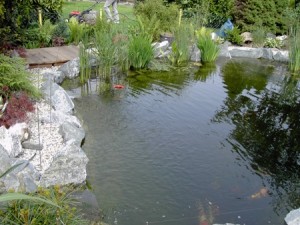Cost calculator pond filter build yourself - Calculate Now
More and more garden owners are planning to create a pond. A pond is a visual eye-catcher for the garden and creates a cozy and natural atmosphere to feel good. Whether it is an ornamental pond, a fish pond or a swimming pond, each type of pond requires appropriate care to remain usable and intact as an ecosystem in the long term.
An important component is an efficient pond filter, which ensures that pollutants are filtered out of the water and that the oxygen content is always high enough for plants and fish to thrive in the pond.
Function of a pond filter
Pond filters come in different varieties, all of which are designed to keep the water in the pond clear and the water quality good. Fish excrement and dead plant debris deprive the water of oxygen. Therefore, it needs to be cleaned with a filtration system. When building or purchasing a pond filter, it is important to consider which substances are to be filtered out of the water and to what extent. A fish pond, for example, places higher demands on a pond filter than an ornamental pond or a swimming pond. The size of the pond also plays a role, because the more water there is to filter, the more powerful the pond filter and pump must be.
Pond filter types overview
Basically, four types of pond filters can be distinguished, which are suitable for all pond types and sizes. The underwater filter is installed before the pump and is particularly suitable for plant ponds and smaller ponds. However, its cleaning is somewhat cumbersome. Unlike the underwater filter, the gravity system is located outside the pond. It is embedded in the ground next to the pond. The pond water enters the filter by means of wall or floor passages. After cleaning, a pump returns the water to the pond.
A gravity system provides good filtration results and is therefore suitable for fish ponds, even those with demanding fish such as koi. Pump-fed filters are placed at the edge of the pond. A pump at the lowest point of the pond carries dirty water to the filter. Pump-fed filters are the right choice for combination ponds. The barrel filter pumps water through several stages of purification, first trapping coarse dirt particles and then using granules to filter pollutants from the water. You can also build a barrel filter yourself with a little craftsmanship and the right materials.
Calculating materials and costs
To build a barrel filter for the garden pond, the following materials are needed: Five plastic rain barrels, each with a capacity of 200 liters. In addition, HT pipes in straight form and as angle pieces are required, as well as rubber seals, fine and coarse felt mats and brushes, furthermore, granulate in the form of basalt, lava stones or gravel.
The financial outlay for these materials is comparatively low and is likely to be between 50 and not much over 100 euros. The biggest variable factor is likely to be the type and quality of the granules. The following construction instructions are designed for a barrel filter with a filter volume of 1,000 liters. With a powerful pump, the filter is suitable for a pond volume between 10,000 and 20,000 liters.
Building instructions for a barrel filter in the garden pond
The principle of the barrel filter is based on the fact that the water passes through 5 stages and is cleaned in them gradually. In this case, the rain barrels represent the individual stages through which the water passes from the top to the bottom and finally from the lowest barrel back into the pond.
The 5 barrels are connected to each other with HT pipes. Cutouts the size of the pipe diameter are cut into each barrel below the rim. Seal the openings with a rubber ring and push the pipe pieces through. Inside the barrel, the pipe is extended with an elbow.
The barrels are placed at a distance of about 5 centimeters from each other, ideally on a slight slope, and the first barrel is connected to the pump via a hose connection. Once the 5 barrels have been prepared in this way, they can be filled.
The first barrel remains empty. It is only used to get the water moving, which means that coarse dirt is already deposited.
In the second barrel, the brushes are placed so that they stand vertically inside and can catch coarse dirt.
The third bar rel is filled with filter mats. They are also placed vertically inside. The mats can already catch somewhat finer particles.
Finally, the fourth garbage can is filled with granulate, which can be basalt, lava or gravel. The stones should have a diameter of one to two centimeters. The granulate is able to bind pollutants from the water.
Finally, the fifth barrel is again filled with filter mats.
The self-made pond filter is ready and immediately ready for use.
But which pond filter is really suitable for my pond?
Every pond is a small ecosystem in which the nutrient cycle must be maintained. If this is not possible by natural means, a pond filter must be used. A natural pond without fish stocking, in which even somewhat turbid water is allowed as long as the natural nutrient cycle remains in balance, does not necessarily need to be filtered. Even if a few native fish species are used that can feed without additional fish food, a pond filter may not be necessary.
However, if many fish are introduced into the pond that require supplemental feeding, excreta and food debris will create an imbalance that must be addressed with a pond filter. A filter must be chosen that fits the size of the pond and the fish stocking. The manufacturers usually give a guideline value for ponds with and without fish. If there are a lot of fish in the pond, or if koi are particularly difficult to keep in balance, a slightly larger filter should be chosen.
When choosing, it is also important to carefully consider whether the filter will fit in the desired location. Pond filters can be quite large, so adequate space must be planned for. Some filters can be buried in the ground so that they do not spoil the look of the garden, while for others this is not possible.
Calculate the cost of a pond filter
The cost of a pond filter can vary widely. Cheap offers can be found from about 50 euros, larger filters can cost several hundred euros. It is important to note whether the offer already includes the pump. If it is a pure filter without pump, there may still be significant costs for this, which are already included in a complete offer.
Pond filter cleaning and maintenance
Of course, it is desirable that the pond filter involves as little work as possible. However, every pond filter must be cleaned at regular intervals. However, many pond filters greatly simplify this work. Some filters have a contamination indicator that alerts the pond owner that the pond needs to be cleaned. It is especially convenient if the filter has an automatic cleaning function. This means that maintenance is minimal and the pond owner can enjoy their garden pond without a lot of work.
Topics: garden & pond technology



